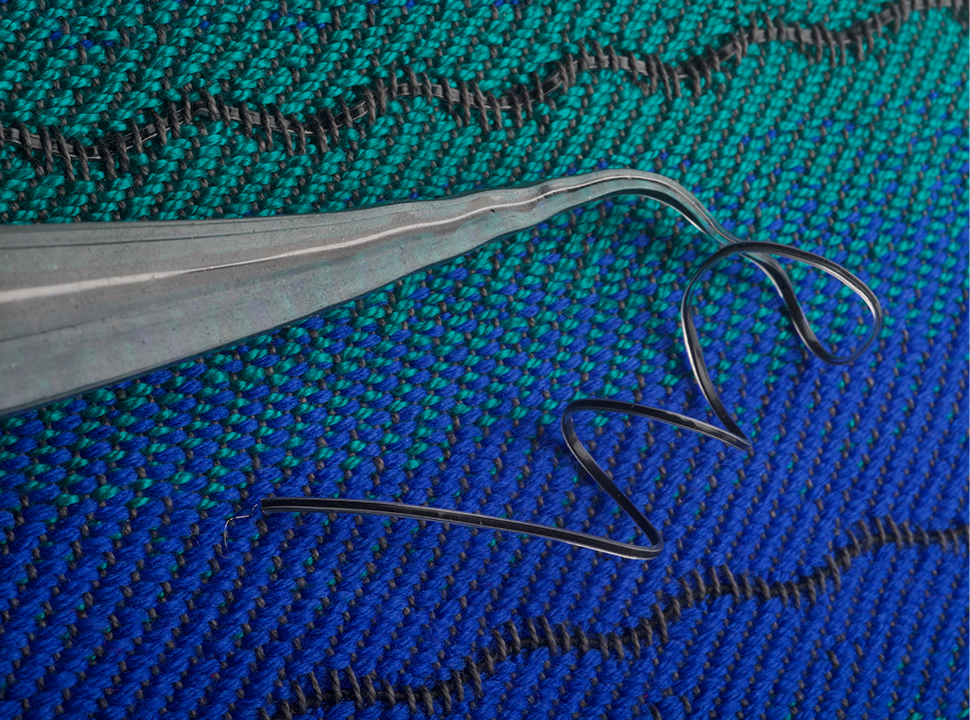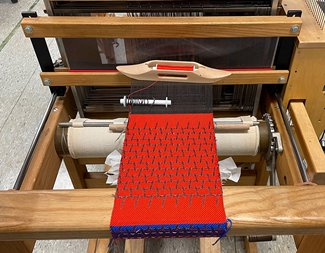Acoustic Fabrics that Compute
Acoustic Fabrics that Compute


Acoustic fiber has six different materials arranged in a precise way. Photo: MIT, Greg Hren
Computers are about to look very different. Instead of the hard, boxy, cumbersome systems we’ve know them to be, they will become even more integrated into our lifestyle as soft, flexible, and beautiful...fabrics.
“A fabric is already a complex hierarchical assembly,” explained Yoel Fink, a professor at the Massachusetts Institute of Technology. “So instead of trying to attach foreign objects to a fabric just to find them rubbed or washed away, we can now put all these new capabilities into the fiber material itself so the fiber assembly, the fabric, becomes a computer.”
Fink’s students at the Department of Materials Science and Engineering are running with this vision coming up with new ideas every day. In fact, they’ve created a fiber that when combined with a fabric becomes a sensitive microphone that can be used to detect a fetal heartbeat so a mother can monitor her baby’s activity in real time. The same fabric could be used to detect a decline in cardiovascular health for someone with a heart condition. They’re also developing a different version of the acoustic fabric that can collect high-speed particles in space to provide new insights about the making of the universe. As Fink put it, these are entirely new ways to think about fabric.
Traditionally, fabrics were used to suppress sound like in a recording studio, movie theater, or even in our own living rooms. But in fact, fabrics are constantly vibrating at a nano-scale, and it was the team’s goal to understand how fabric responds to acoustic stimuli, harness that response, convert it into electrical signals, and ultimately useful information.
“The fabric you're wearing is exposed to the soundtrack of your life,” Fink said. “Every interaction that you have has an acoustic framework to it—every conversation, the music you listen to, every bird you hear—everything that goes on in the world has some information associated with it. Even your body itself is transmitting information. Unfortunately, until now this potentially valuable soundtrack was erased and turned into heat by the fabric.”
To create a fabric that detects sound, the team studied the human ear, one of the most sensitive and complex systems in the human body. As sound waves, also known as pressure waves, travel down the ear canal, they encounter the tympanic membrane (eardrum), which converts the pressure waves into mechanical vibrations. These in turn travel through three tiny bones known as ossicles that further transmit the sound to the cochlea, which generates it as a nerve impulse to the brain.
More for You: Using Muscle to Spin Fiber
“Fibers play a very prominent role at both ends of the auditory system,” he elaborated. “In the tympanic membrane, they help convert pressure waves into mechanical waves, and in the cochlea different fibers convert waves into electrical signals. So, the question became, can we create an assembly of fibers in a flat fabric that can detect sound just like the ear?”
The team discovered that when sound hits fabric, small wavelike structures are created. The fiber they designed had to be flexible enough to bend with the waves similar to how seaweed bends on the ocean’s surface, and yet at the same time generate a strong electrical signal. Both of these requirements, flexibility and a strong electrical signal in response to bending, helped define the design of the fiber.
One of the challenges in achieving this was that the waves created in the fabric were on a nanometer scale, making them very difficult to detect. The fiber is made of a soft, flexible, and elastic cladding while having a piezoelectric layer inside the fiber structure that is sandwiched between two conducting plates. All told, the fiber has six different materials arranged in a very precise way.
When the team inserted one fiber into a fabric, they found they could detect sound at 1/10th of a millionth of atmosphere pressure. Placing two separate fibers into a fabric allowed the team to demonstrate a directional detection of sound with very high angular sensitivity and accuracy.
Editor's Pick: Unlocking Composite Fiber for Recycling
As Fink’s students learn and discover new ways to computerize fibers, another team at the Rhode Island School of Design is exploring how to construct garments with the fibers that people will actually wear. This multidisciplinary approach and unique partnership between the institutions will hopefully inspire a wide range of fashion choices in the future that are not only technologically functional, but also sustainable.
“Our clothes will become just as valuable as our cell phones, and perhaps a whole lot more,” Fink said. “Fabrics will soon provide important services to us, which will lead to an appreciation in the value of fabrics. We don’t easily discard objects that are very valuable to us.”
The challenge to today’s engineers is to also begin to imagine all of the possible ways that computing fabrics may be incorporated into the tech blueprints of the future.
Cassandra Martindell is a technology writer in Groveport, Ohio.
“A fabric is already a complex hierarchical assembly,” explained Yoel Fink, a professor at the Massachusetts Institute of Technology. “So instead of trying to attach foreign objects to a fabric just to find them rubbed or washed away, we can now put all these new capabilities into the fiber material itself so the fiber assembly, the fabric, becomes a computer.”
Fink’s students at the Department of Materials Science and Engineering are running with this vision coming up with new ideas every day. In fact, they’ve created a fiber that when combined with a fabric becomes a sensitive microphone that can be used to detect a fetal heartbeat so a mother can monitor her baby’s activity in real time. The same fabric could be used to detect a decline in cardiovascular health for someone with a heart condition. They’re also developing a different version of the acoustic fabric that can collect high-speed particles in space to provide new insights about the making of the universe. As Fink put it, these are entirely new ways to think about fabric.
Traditionally, fabrics were used to suppress sound like in a recording studio, movie theater, or even in our own living rooms. But in fact, fabrics are constantly vibrating at a nano-scale, and it was the team’s goal to understand how fabric responds to acoustic stimuli, harness that response, convert it into electrical signals, and ultimately useful information.
“The fabric you're wearing is exposed to the soundtrack of your life,” Fink said. “Every interaction that you have has an acoustic framework to it—every conversation, the music you listen to, every bird you hear—everything that goes on in the world has some information associated with it. Even your body itself is transmitting information. Unfortunately, until now this potentially valuable soundtrack was erased and turned into heat by the fabric.”
To create a fabric that detects sound, the team studied the human ear, one of the most sensitive and complex systems in the human body. As sound waves, also known as pressure waves, travel down the ear canal, they encounter the tympanic membrane (eardrum), which converts the pressure waves into mechanical vibrations. These in turn travel through three tiny bones known as ossicles that further transmit the sound to the cochlea, which generates it as a nerve impulse to the brain.
More for You: Using Muscle to Spin Fiber
“Fibers play a very prominent role at both ends of the auditory system,” he elaborated. “In the tympanic membrane, they help convert pressure waves into mechanical waves, and in the cochlea different fibers convert waves into electrical signals. So, the question became, can we create an assembly of fibers in a flat fabric that can detect sound just like the ear?”
The team discovered that when sound hits fabric, small wavelike structures are created. The fiber they designed had to be flexible enough to bend with the waves similar to how seaweed bends on the ocean’s surface, and yet at the same time generate a strong electrical signal. Both of these requirements, flexibility and a strong electrical signal in response to bending, helped define the design of the fiber.
One of the challenges in achieving this was that the waves created in the fabric were on a nanometer scale, making them very difficult to detect. The fiber is made of a soft, flexible, and elastic cladding while having a piezoelectric layer inside the fiber structure that is sandwiched between two conducting plates. All told, the fiber has six different materials arranged in a very precise way.
When the team inserted one fiber into a fabric, they found they could detect sound at 1/10th of a millionth of atmosphere pressure. Placing two separate fibers into a fabric allowed the team to demonstrate a directional detection of sound with very high angular sensitivity and accuracy.
Editor's Pick: Unlocking Composite Fiber for Recycling
As Fink’s students learn and discover new ways to computerize fibers, another team at the Rhode Island School of Design is exploring how to construct garments with the fibers that people will actually wear. This multidisciplinary approach and unique partnership between the institutions will hopefully inspire a wide range of fashion choices in the future that are not only technologically functional, but also sustainable.
“Our clothes will become just as valuable as our cell phones, and perhaps a whole lot more,” Fink said. “Fabrics will soon provide important services to us, which will lead to an appreciation in the value of fabrics. We don’t easily discard objects that are very valuable to us.”
The challenge to today’s engineers is to also begin to imagine all of the possible ways that computing fabrics may be incorporated into the tech blueprints of the future.
Cassandra Martindell is a technology writer in Groveport, Ohio.







